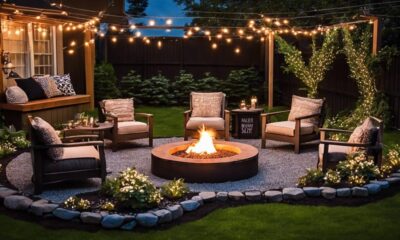Decor
What Are Chinese New Year Decorations
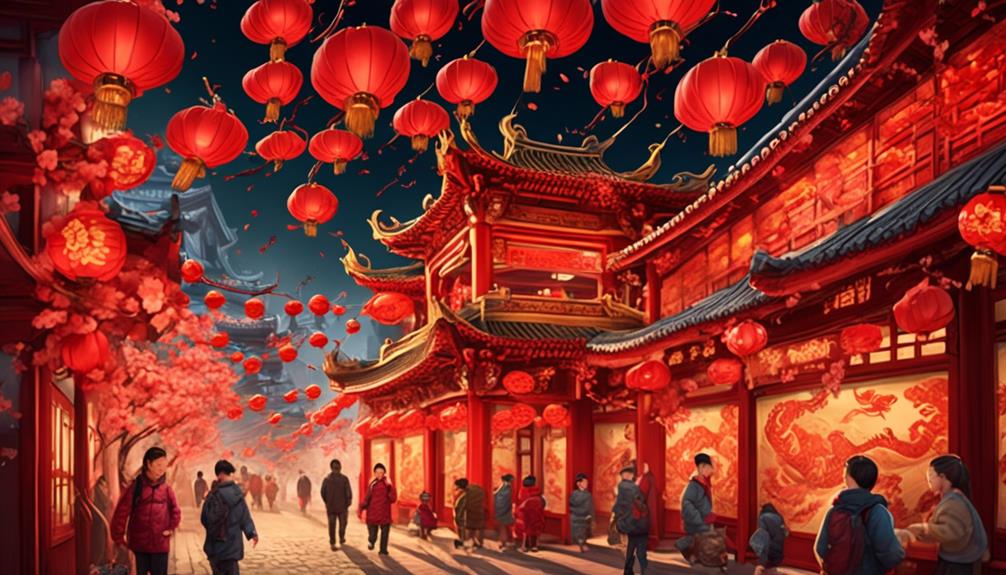
During the Chinese New Year celebrations, a significant and widely observed holiday in China, an intriguing figure comes to light: in 2019, it is estimated that around 1.4 billion individuals partook in the festivities of this momentous event.
As we delve into the world of Chinese New Year decorations, we find ourselves captivated by the rich symbolism and cultural significance they hold. Red lanterns illuminate the streets, symbolizing good luck and warding off evil spirits. Elaborate paper cuttings adorn windows and doors, adding a touch of intricate beauty. Couplets, featuring poetic phrases, bless homes with good fortune. Chinese character Fu, meaning 'luck,' is displayed prominently to invite prosperity. Door gods protect households from harm, while vibrant window stickers depict scenes of joy and abundance. Nianhua and New Year scrolls showcase traditional art and blessings. Auspicious animals such as dragons and lions dance in vibrant parades.
These decorations not only create a festive atmosphere, but also serve as reminders of the rich cultural heritage and hopes for a prosperous year ahead.
Key Takeaways
- Chinese New Year decorations are rich in symbolism and are believed to bring good luck and ward off evil spirits.
- Traditional designs such as red lanterns, paper cuttings, couplets, and Nianhua decorations are widely used during the celebrations.
- Fish, peony, lantern, Fu character, and flower arrangements are some of the symbolic elements used in Chinese New Year decorations.
- Chinese New Year decorations also hold cultural significance, such as Kumquat Trees symbolizing wealth, door gods bringing good luck, and dragon dance symbolizing power and prosperity.
Red Lanterns
Red lanterns are an iconic symbol of Chinese New Year celebrations, illuminating the streets with their vibrant red hues and casting a warm glow of joy and prosperity. These lanterns hold deep cultural significance and are an integral part of the festivities. Red lantern festivals are organized across China and other parts of the world to commemorate the lunar new year.
The cultural significance of red lanterns lies in their symbolism. In Chinese culture, red is considered a color of luck and happiness. The lanterns are believed to ward off evil spirits and bring good fortune for the coming year. They're also seen as a representation of family unity and prosperity.
During the Chinese New Year celebrations, the streets are adorned with countless red lanterns. Their mesmerizing glow not only adds to the festive atmosphere but also serves as a reminder of the rich heritage and traditions that have been passed down through generations. The lanterns are intricately designed, with various patterns and motifs, showcasing the craftsmanship and artistic skills of the Chinese people.
In comparison to other decorations, red lanterns hold a special place in Chinese New Year celebrations. They aren't only visually appealing but also carry a deeper meaning, making them an essential element of the festivities. As we immerse ourselves in the joyful ambiance of red lantern festivals, we can truly appreciate the cultural significance and beauty they bring to Chinese New Year celebrations.
Paper Cuttings

When it comes to Chinese New Year decorations, paper cuttings hold great significance. These intricate designs aren't just visually appealing, but they also carry symbolic meanings.
Each paper cutting tells a story or represents a specific theme, such as good luck, prosperity, or longevity. From delicate flowers to intricate animal figures, the traditional designs of paper cuttings add a touch of elegance and cultural charm to the festive atmosphere of Chinese New Year celebrations.
Symbolic Meanings
Paper cuttings in Chinese New Year decorations are not just decorative pieces, but also carry deep symbolic meanings. These delicate artworks, often made from red paper, are meticulously crafted and can be seen adorning homes and public spaces during the festive season. Each design holds its own significance, embodying wishes for good fortune, prosperity, and happiness.
Symbolic Meanings of Paper Cuttings in Chinese New Year Decorations:
| Design | Symbolic Meaning |
|---|---|
| Fish | Abundance and surplus |
| Peony | Prosperity and good fortune |
| Lantern | Bright future and luck |
The fish design, representing abundance and surplus, is often displayed alongside symbolism in food, such as oranges and dumplings, which are associated with good luck and wealth. Similarly, the peony design symbolizes prosperity and good fortune, reflecting the hope for a prosperous year ahead. Lanterns, another common paper cutting motif, represent a bright future and luck, illuminating the path to success.
These intricate paper cuttings, with their deep symbolic meanings, not only add beauty to Chinese New Year decorations but also serve as reminders of the hopes and aspirations for a prosperous and auspicious year.
Traditional Designs
As we explore the subtopic of traditional designs in Chinese New Year decorations, we delve deeper into the intricate art of paper cuttings and the cultural significance they hold.
Paper cuttings, known as Jianzhi, have been an integral part of Chinese culture for centuries and are often used as decorative elements during the Spring Festival. These delicate designs are meticulously handcrafted, with each piece telling a unique story and symbolizing good fortune and blessings for the coming year.
The cultural significance of paper cuttings lies in their ability to convey wishes for happiness, longevity, and prosperity. They also serve as a way to preserve ancient traditions and showcase the artistic skills of the Chinese people.
In addition, paper cuttings are often used to decorate windows and doors, creating a festive atmosphere and warding off evil spirits.
Couplets
Decorating for Chinese New Year is incomplete without the vibrant and auspicious tradition of hanging couplets. Couplets, also known as 'Chunlian' in Chinese, are vertical banners containing poetic verses written in calligraphy. These couplets are an essential part of Chinese New Year decorations, symbolizing good luck and prosperity for the coming year.
Couplet designs vary, but they usually consist of two phrases with parallel structures and complementary meanings. The verses are carefully chosen to express blessings, wishes, and hopes for the new year. Common themes include wealth, health, happiness, and harmony. The words are meticulously crafted to create a harmonious rhythm and convey positive energy.
When it comes to couplet placement, there are certain traditions to follow. The couplets are usually placed on both sides of the main entrance, with the first line on the right and the second line on the left. This is believed to bring balance and harmony to the household. Some people also hang couplets inside their homes, such as above the fireplace or on the walls of the living room.
In addition to their decorative function, couplets also serve as a form of expression and communication. They're a way for families to share their hopes and aspirations for the new year with visitors and passersby. The vibrant colors and meaningful words of the couplets create a festive atmosphere and add to the overall joy of Chinese New Year celebrations.
Chinese Character Fu
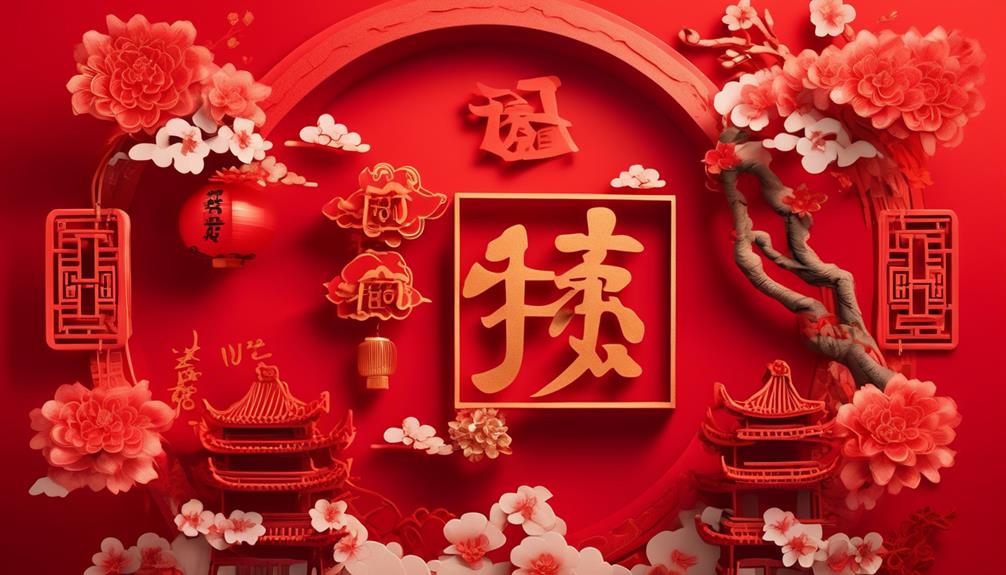
After exploring the significance of couplets in Chinese New Year decorations, we now turn our attention to another iconic element, the Chinese character Fu. The Chinese character Fu, which means 'blessing' or 'good fortune,' holds great symbolic and cultural significance during the Chinese New Year festivities.
Here are three reasons why the Chinese character Fu is an essential part of Chinese New Year decorations:
- Symbolic Significance: The character Fu is traditionally written in black ink on a square piece of red paper. Red symbolizes good luck and happiness in Chinese culture, while the character Fu represents blessings and prosperity. Placing the character Fu upside down on a door or window is believed to invite good fortune and blessings into the home.
- Cultural Significance: The character Fu has been used in Chinese culture for centuries and is deeply rooted in the Chinese tradition. It's seen as a way to express good wishes and hopes for a prosperous and harmonious year ahead. The character Fu is often displayed alongside other Chinese New Year decorations, such as lanterns and red envelopes, to create an auspicious atmosphere.
- Holistic Meaning: The character Fu not only represents material wealth and success but also encompasses overall happiness, health, and harmony in life. It's a reminder to appreciate and cherish the blessings one has and to strive for a fulfilling and prosperous future.
Door Gods

One of the most fascinating aspects of Chinese New Year decorations is the presence of Door Gods, who play a significant role in safeguarding homes and bringing good luck during the festive season. Door God beliefs have been deeply ingrained in Chinese culture for centuries, with their origins dating back to ancient times. These deities are believed to have the power to ward off evil spirits, protect against misfortune, and bring blessings to the household.
The history of Door Gods can be traced back to Daoism and Chinese folklore. Originally, they were depicted as fierce generals or warriors, armed with weapons and dressed in armor, symbolizing their strength and ability to defend the home. Over time, the depiction of Door Gods evolved, and they began to be portrayed as more benevolent figures, often accompanied by auspicious symbols such as dragons, fish, and peaches.
Door Gods are typically placed on the front door or gate of a house during Chinese New Year. They're often depicted in pairs, with one god on each side of the entrance. The gods are believed to work together to protect the home from negative energy and invite positive energy and good luck into the household.
Flower Arrangements
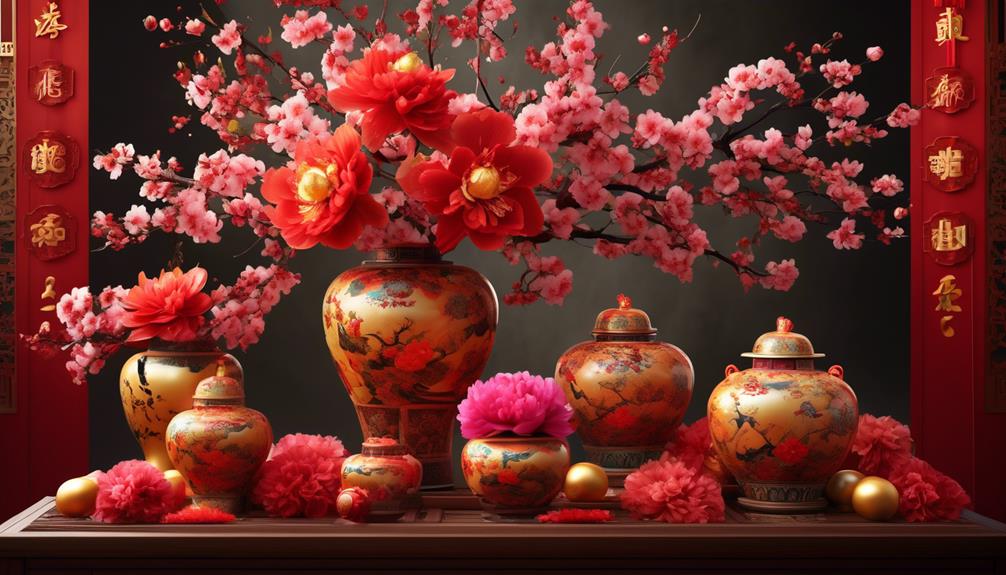
Arranging flowers for Chinese New Year is a cherished tradition that adds beauty and symbolism to the festive decorations. Floral arrangements hold deep cultural significance during this auspicious time, symbolizing good luck, prosperity, and the arrival of spring. Here are three types of flower arrangements commonly seen during Chinese New Year:
- Kumquat Trees: These miniature citrus trees are adorned with vibrant orange fruits, symbolizing wealth and good fortune. The kumquat's round shape resembles gold coins, making it a popular choice for New Year decorations. Placing a kumquat tree at the entrance of the house is believed to bring prosperity and abundance in the coming year.
- Peach Blossoms: Symbolizing longevity and romance, peach blossoms are a common sight during Chinese New Year. Their delicate pink flowers represent feminine beauty and love. Peach blossom branches are often arranged in vases and displayed in homes to welcome happiness, harmony, and new beginnings.
- Narcissus: Also known as the 'water fairy,' narcissus flowers symbolize good luck and prosperity. These elegant white flowers are often arranged in shallow bowls filled with water, allowing the bulbs to grow and bloom during the New Year celebrations. The narcissus' fragrance and pure white color are believed to bring good fortune and ward off evil spirits.
Flower arrangements play a significant role in Chinese New Year celebrations, bringing joy, abundance, and positive energy into households. They aren't only visually appealing but also hold deep cultural meaning, making them an essential part of this festive occasion.
Kumquat Trees
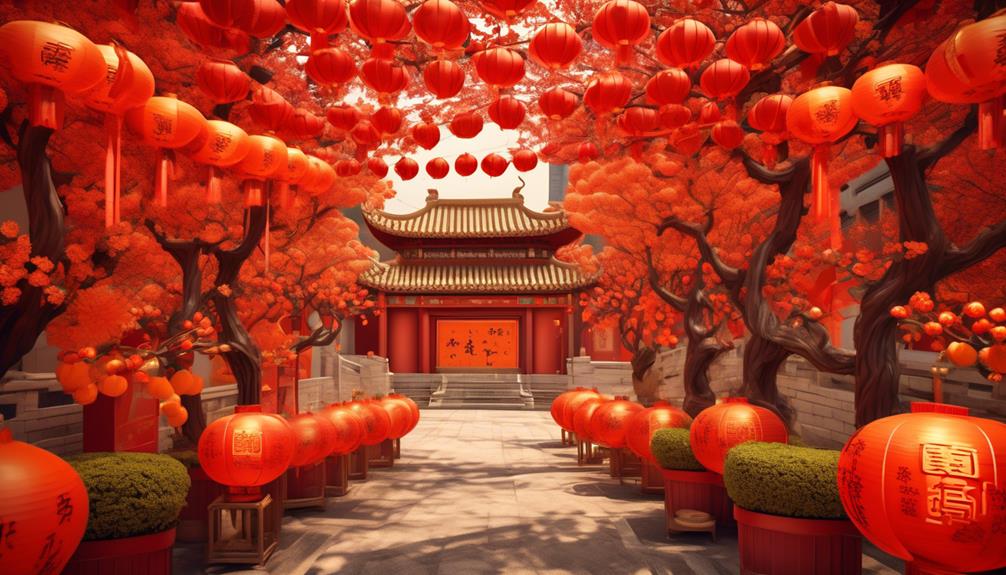
Floral arrangements hold deep cultural significance during Chinese New Year, and one popular choice that symbolizes wealth and good fortune is the kumquat tree. The kumquat tree, scientifically known as Fortunella, is a small evergreen tree that bears small, vibrant orange fruits resembling miniature oranges. In Chinese culture, the kumquat tree is highly revered for its auspicious qualities and is often displayed during the Lunar New Year celebrations.
Kumquat tree care is relatively easy, making it a favored choice for home decorations. These trees thrive in well-drained soil and require regular watering and some sunlight. Pruning the tree helps maintain its shape and encourage fruit production.
The significance of the kumquat tree in Chinese culture goes beyond its beauty. The Chinese word for kumquat, "gam gwat," sounds similar to the words for "gold" and "luck" in Cantonese. This linguistic similarity strengthens the association between the kumquat tree and wealth and good fortune. Additionally, the vibrant orange color of the fruit represents happiness and prosperity.
To further appreciate the cultural significance of the kumquat tree during Chinese New Year, let's take a closer look at its symbolism in a comparative table:
| Symbolism | Meaning |
|---|---|
| Wealth | Symbolizes abundance and prosperity. |
| Good Fortune | Brings luck and positive energy. |
| Happiness | Represents joy and contentment. |
| Longevity | Signifies a long and fulfilling life. |
Firecrackers

Firecrackers, a staple of Chinese New Year celebrations, add a vibrant and explosive element to the festivities. These loud and colorful explosives have a rich history and are an integral part of the cultural traditions surrounding this holiday. Here are some fascinating facts about firecrackers:
- Firecracker Safety:
- Always handle firecrackers with caution and follow proper safety guidelines.
- Keep a safe distance from people, animals, and flammable objects while lighting firecrackers.
- Never hold a lit firecracker in your hand or throw it at others.
- History of Firecrackers:
- Firecrackers were invented in ancient China over 2,000 years ago, during the Han Dynasty.
- Initially used as a way to ward off evil spirits, firecrackers became a symbol of good luck and fortune.
- The loud noise produced by firecrackers was believed to scare away demons and bring blessings for the coming year.
- Comparative Significance:
- In comparison to other Chinese New Year decorations, firecrackers hold a special place as they represent the explosive energy needed to drive away negativity and welcome positive vibes.
- While other decorations create a festive atmosphere, firecrackers actively participate in the celebration by creating a loud and joyful noise.
Firecrackers are a thrilling and essential part of Chinese New Year celebrations, but it's crucial to prioritize safety when using them. Understanding the history and significance of firecrackers adds depth to the cultural appreciation of this traditional practice.
Lion and Dragon Dances
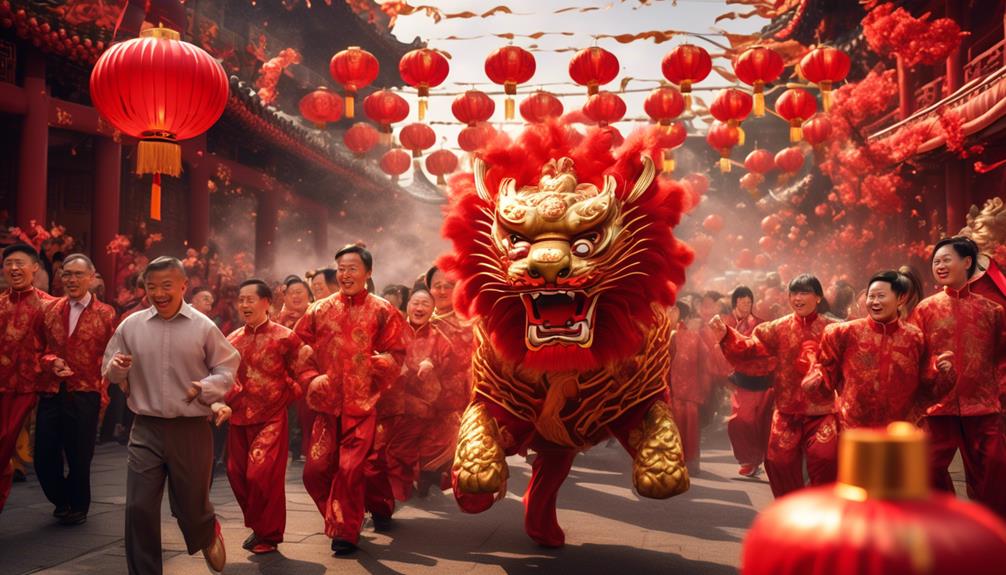
As we move from the explosive energy of firecrackers, the next subtopic of discussion takes us into the captivating realm of Lion and Dragon Dances. These traditional Chinese performances are an integral part of the Chinese New Year celebrations, captivating audiences with their vibrant colors, rhythmic movements, and rich cultural symbolism.
The lion dance, performed by two dancers inside a lion costume, is believed to bring good luck and ward off evil spirits. The lion's movements are intricate and graceful, mimicking the actions of a real lion. The dance is accompanied by the sound of drums, cymbals, and gongs, creating a lively and energetic atmosphere.
On the other hand, the dragon dance is a grand spectacle that requires a team of performers. The dragon, which can stretch up to 100 feet long, is controlled by dancers who manipulate its body using poles. The dragon's movements are dynamic and majestic, symbolizing power, wisdom, and prosperity. The dragon dance is accompanied by the beating of drums, the clashing of cymbals, and the loud cheers of the spectators.
Both the lion dance and the dragon dance showcase the rich cultural heritage of China and are believed to bring good fortune and blessings for the upcoming year. These captivating performances, with their intricate choreography and vibrant costumes, continue to mesmerize audiences around the world, making them a must-see spectacle during Chinese New Year celebrations.
Window Stickers
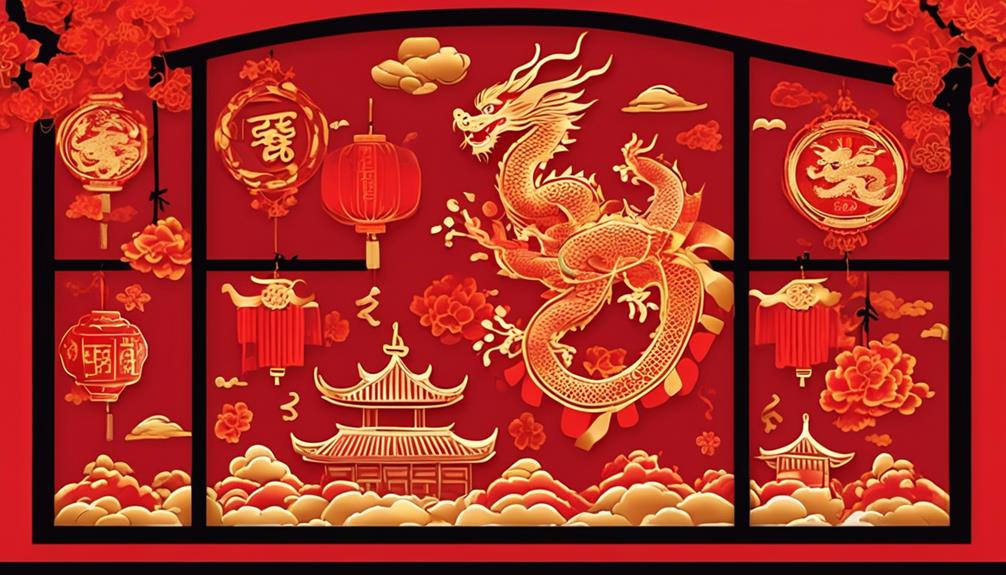
When it comes to Chinese New Year decorations, window stickers play an important role in adding a festive touch to homes and businesses. These stickers aren't just decorative, but also carry symbolic meanings.
Traditional designs often feature auspicious symbols such as the Chinese character for luck, gold ingots, and images of the zodiac animal for the year.
Symbolic Meanings
Symbolic meanings associated with window stickers during Chinese New Year are rich in cultural significance and serve as visual representations of auspicious blessings and wishes. These vibrant stickers, often made of red paper, are commonly seen adorning windows and doors during the festive season. Here are three key aspects that make these decorations so meaningful:
- Symbolic Colors: Window stickers are often adorned with symbolic colors, with red being the most prominent. Red symbolizes luck, joy, and prosperity in Chinese culture. Other colors, such as gold and yellow, are also used to represent wealth and good fortune.
- Traditional Customs: Chinese New Year window stickers often feature traditional motifs such as Chinese characters for luck, happiness, and longevity. Additionally, images of mythical creatures like dragons and phoenixes symbolize power and rebirth.
- Blessings and Wishes: The stickers aren't only visually appealing but also carry specific blessings and wishes. Common phrases like 'May you have a prosperous year' or 'May all your wishes come true' are often written on the stickers, spreading positive energy and good wishes to those who see them.
These symbolic window stickers play an essential role in creating a festive atmosphere and spreading good fortune during Chinese New Year celebrations.
Traditional Designs
The traditional designs of Chinese New Year window stickers showcase a myriad of intricate patterns and symbols, each with their own unique cultural significance. These stickers, known as "chuang hua" in Mandarin, are a type of traditional craft that has been passed down through generations. They are typically made from red paper, which symbolizes good luck and prosperity in Chinese culture. The designs often feature motifs such as flowers, animals, and Chinese characters, all of which hold deep cultural meanings. For example, the peony flower represents wealth and honor, while the fish symbolizes abundance and prosperity. The Chinese character "fu," meaning good fortune, is another popular design. These window stickers are not only decorative but also serve as a way to invite blessings and ward off evil spirits during the festive season.
| Traditional Design | Cultural Significance |
|---|---|
| Peony | Wealth and honor |
| Fish | Abundance and prosperity |
| Chinese character "fu" | Good fortune |
Nianhua

Nianhua, a traditional form of Chinese New Year decoration, adds vibrant color and auspicious symbols to homes and public spaces. Nianhua symbolism holds great cultural significance and is deeply rooted in Chinese traditions. Here are three aspects that make nianhua a unique and cherished part of the celebrations:
- Auspicious Motifs: Nianhua features a variety of auspicious symbols, such as the Chinese character 'fu' (福), meaning good fortune, and images of deities like the God of Wealth. These motifs are believed to bring blessings and prosperity to the household.
- Artistic Techniques: Nianhua showcases exquisite craftsmanship and artistic techniques. Intricate paper-cutting, delicate embroidery, and detailed paintings are commonly used to create beautiful nianhua artworks. These techniques not only enhance the visual appeal but also showcase the skill and creativity of the artisans.
- Historical Significance: Nianhua has a rich historical significance, reflecting the changes in Chinese society and culture over time. The themes and styles of nianhua have evolved, mirroring the values and aspirations of different periods. From depicting traditional rural scenes to celebrating modern achievements, nianhua captures the essence of Chinese history and heritage.
New Year Scrolls

As we continue exploring the vibrant world of Chinese New Year decorations, we now turn our attention to the captivating tradition of New Year Scrolls. These scrolls, also known as chunlian or spring couplets, are an integral part of the Chinese New Year celebration. They're typically hung on both sides of the door or inside the house to bring good luck and blessings for the coming year.
New Year Scrolls are made of red paper or silk and are adorned with traditional designs and auspicious phrases. The designs often feature intricate calligraphy, symbolic images, and vibrant colors that represent good fortune, happiness, and prosperity. Common motifs include Chinese characters for wealth, longevity, luck, and harmony, as well as images of flowers, birds, dragons, and the zodiac animal of the year.
These scrolls are carefully selected or created by families to reflect their hopes and wishes for the new year. They're considered not only as decorative items but also as a form of art that carries deep cultural meaning. The phrases written on the scrolls are carefully chosen to convey positive messages and well-wishes for the household.
In comparison to other Chinese New Year decorations like Nianhua, New Year Scrolls are more personalized and customizable. Families can choose the specific designs and phrases that resonate with them, making each scroll unique and meaningful. These scrolls are often passed down from generation to generation, becoming treasured family heirlooms that embody the spirit of the Chinese New Year.
Auspicious Animals
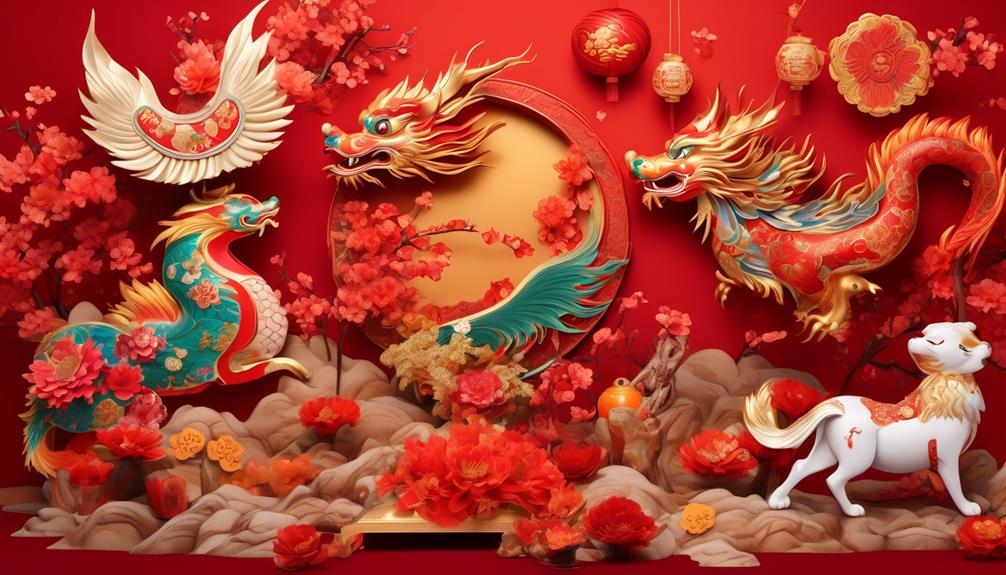
When it comes to Chinese New Year decorations, auspicious animals play a significant role in symbolizing good luck and prosperity. From the traditional zodiac animals to other symbolic creatures, these animals are believed to bring blessings and ward off negative energy.
Many decorations during this festive season feature animal motifs, such as lion dances, dragon lanterns, and paper cuttings, adding a lively and vibrant touch to the celebrations.
Symbolic Meanings of Animals
The symbolic meanings of animals play a significant role in Chinese New Year decorations. In particular, the traditional zodiac animals hold great importance.
The Rat, the first animal in the Chinese zodiac, symbolizes intelligence, wealth, and abundance. It's believed to bring good luck and prosperity for the coming year.
The Tiger, known for its bravery and strength, represents power and protection. It's often displayed to ward off evil spirits and bring courage.
The Dragon, a legendary creature, is a symbol of luck, success, and vitality. Its presence signifies prosperity and good fortune.
Each animal carries its own unique symbolism and is carefully chosen to bring positive energy and blessings. These auspicious animals not only add beauty to the decorations but also serve as reminders of the qualities and values that are highly cherished in Chinese culture.
Traditional Zodiac Animals
The traditional zodiac animals, also known as auspicious animals, have deep-rooted symbolism and are an integral part of Chinese New Year decorations. These animals are based on the Chinese zodiac, which consists of twelve different animals, each representing a specific year in a twelve-year cycle.
Each animal has its own unique characteristics and traits, which are believed to influence the personality and destiny of individuals born in that year. For example, the Rat is considered to be intelligent and resourceful, while the Ox is known for its strength and determination. The Tiger is associated with courage and bravery, while the Rabbit symbolizes kindness and gentleness.
These traditional zodiac animals not only add color and charm to Chinese New Year decorations, but they also serve as a reminder of the rich cultural heritage and beliefs of the Chinese people.
Animal-Themed Decorations
Auspicious animals play a significant role in Chinese New Year decorations, adding a touch of symbolism and cultural significance to the festivities. These animal-themed decorations often feature the traditional zodiac animals, each representing a specific year in the Chinese zodiac cycle.
Here are three sub-lists that showcase the different types of animal-themed decorations:
- Zodiac Animal Figurines:
- These figurines are typically made of porcelain or clay.
- They're beautifully crafted and depict the zodiac animals in intricate detail.
- People place these figurines in their homes to bring good luck and protection for the coming year.
- Paper Cutouts:
- Paper cutouts of the zodiac animals are commonly used to decorate windows and doors.
- These delicate pieces of art are believed to ward off evil spirits and bring blessings into the household.
- The paper cutouts are often red, symbolizing good fortune and joy.
- Lanterns:
- Lanterns shaped like the zodiac animals are a popular decoration during Chinese New Year.
- These colorful lanterns hang in streets and homes, illuminating the festive atmosphere.
- They symbolize prosperity and happiness, inviting good luck and positive energy.
Incorporating animal-themed decorations into Chinese New Year celebrations not only adds a festive touch but also reinforces the cultural significance of the traditional zodiac animals.
Frequently Asked Questions
What Is the Significance of the Color Red in Chinese New Year Decorations?
The color red holds great significance in Chinese culture, especially during Chinese New Year celebrations. It symbolizes good luck, happiness, and prosperity. In traditional Chinese New Year clothing, the color red is commonly worn to ward off evil spirits and bring good fortune.
Red decorations are abundant during this festive time, adorning homes and streets with lanterns, couplets, and paper cutouts. The vibrant red hues create a sense of joy and excitement, welcoming the new year with auspicious energy.
How Are Paper Cuttings Used to Decorate During Chinese New Year?
During Chinese New Year, paper cuttings are commonly used to decorate homes and public spaces.
Traditional techniques are employed to create intricate designs that represent various auspicious symbols and themes, such as prosperity, good luck, and longevity.
These paper cuttings are often displayed on doors, windows, and walls, adding a vibrant and festive atmosphere to the surroundings.
The symbolism behind Chinese New Year decorations is deeply rooted in cultural beliefs and customs, and each decoration carries its own unique meaning and significance.
What Is the Meaning Behind the Chinese Character "Fu" and How Is It Used in Decorations?
The meaning behind the Chinese character 'fu' is abundance and good fortune. It's a traditional symbol used in Chinese New Year decorations.
The 'fu' character is often displayed upside down, as the word for 'upside down' in Chinese sounds similar to the word for 'arrive', symbolizing the arrival of good luck.
It's commonly seen on red paper cuttings and couplets displayed on doors and windows. These decorations are believed to bring blessings and prosperity to the household.
Who Are the Door Gods and What Role Do They Play in Chinese New Year Celebrations?
The door gods play a significant role in Chinese New Year celebrations. They're believed to protect the household from evil spirits and bring good luck for the coming year. These deities are often depicted on Chinese New Year door decorations, guarding the entrance to the home.
They're usually portrayed as fierce warriors, armed with weapons and dressed in traditional attire. The presence of the door gods is believed to ensure a prosperous and harmonious year ahead.
What Are Some Traditional Flower Arrangements Used During Chinese New Year and Their Symbolic Meanings?
During Chinese New Year, traditional flower arrangements are like bursts of color and fragrance that fill our homes with joy and renewal.
These arrangements hold deep symbolic meanings in Chinese culture. From the vibrant red blooms of peonies, symbolizing prosperity and good fortune, to the elegant orchids representing refinement and beauty, each flower carries its own significance.
The intricate combination of flowers and foliage creates a harmonious display, reminding us of the interconnectedness of nature and the celebration of new beginnings.
What are the Most Common Chinese New Year Decorations?
The most common Chinese New Year decorations used include red lanterns, which symbolize good luck and happiness. Additionally, you’ll often see red paper cut-outs with intricate designs adorning doors and windows to ward off evil spirits. Also, the color red is prominent throughout, as it represents good fortune and joy.
Conclusion
In conclusion, Chinese New Year decorations are like vibrant bursts of joy that breathe life into every corner of a home. They're the colorful lanterns that guide us towards prosperity, the intricate paper cuttings that tell stories of tradition and blessings, and the powerful door gods that protect our loved ones.
Just like the auspicious animals and symbols that adorn the walls, these decorations bring an atmosphere of harmony and good fortune that transcends time and space.
- About the Author
- Latest Posts
Introducing Ron, the home decor aficionado at ByRetreat, whose passion for creating beautiful and inviting spaces is at the heart of his work. With his deep knowledge of home decor and his innate sense of style, Ron brings a wealth of expertise and a keen eye for detail to the ByRetreat team.
Ron’s love for home decor goes beyond aesthetics; he understands that our surroundings play a significant role in our overall well-being and productivity. With this in mind, Ron is dedicated to transforming remote workspaces into havens of comfort, functionality, and beauty.
Southeast Asia Decor
Batik: Cultural Symbolism in Modern Interior Design
Key to enhancing modern interiors, batik’s vibrant patterns tell stories of culture and craftsmanship; discover how to transform your space with meaningful design.
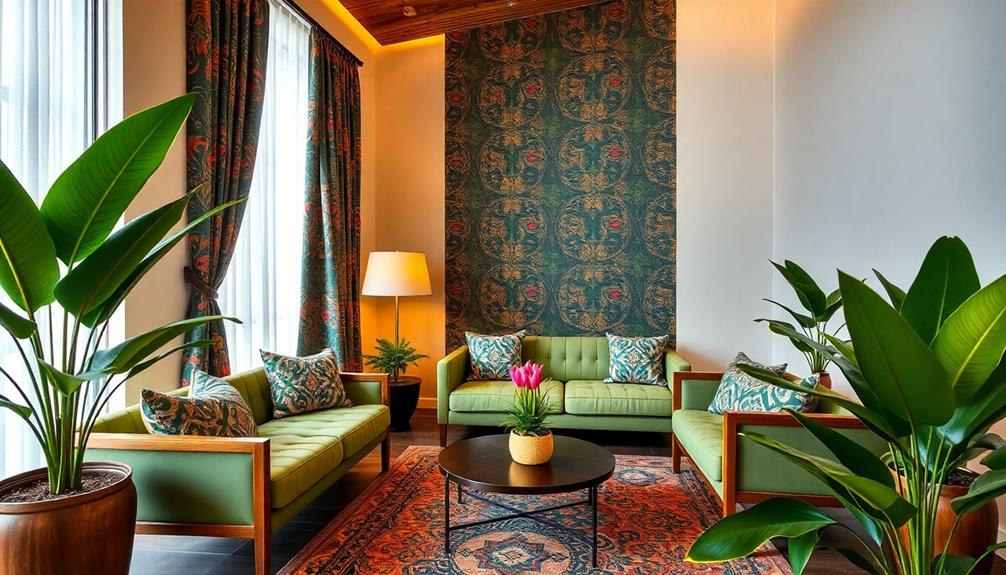
Batik isn't just a beautiful textile; it's a vibrant cultural symbol that enriches modern interior design. You can incorporate its intricate motifs and bright colors into your home, enhancing both aesthetics and storytelling. Each pattern holds meaning, like the Kawung symbolizing balance or Parang representing strength. These designs can be used in cushions, curtains, and art pieces, bringing depth and emotion to your space. By integrating batik, you're not just decorating; you're connecting your environment to a rich heritage. If you explore further, you'll uncover how batik transforms interiors into narratives of culture and craftsmanship.
Key Takeaways
- Batik's intricate motifs reflect cultural values, enhancing narratives, and transforming interior spaces into rich tapestries of stories.
- Contemporary batik blends traditional designs with modern aesthetics, making it suitable for various decor elements like cushions and curtains.
- Regional variations in batik patterns showcase Indonesia's diverse cultural heritage, enriching interior design with unique symbolic meanings.
- Incorporating sustainable materials and eco-friendly practices in batik production supports local artisans and preserves cultural heritage.
- Batik's global influence and recognition as a cultural symbol elevate its significance in modern interior design, connecting spaces to deeper narratives.
Historical Significance of Batik
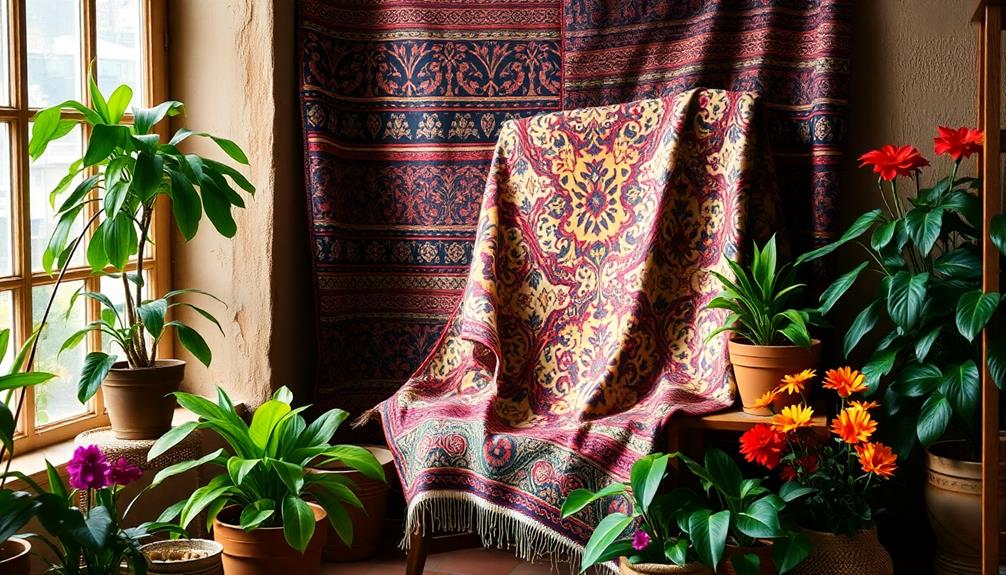
Although batik may seem like just a beautiful textile to you, its historical significance runs deep, rooted in over 2000 years of tradition originating in Indonesia. The term "batik" comes from the Javanese word "ambatik," meaning cloth with little dots, which reflects the intricate dyeing techniques that define this ancient art form.
The vibrant colors and intricate designs found in batik are reminiscent of other Indonesian handicrafts, such as the unique artistic expressions seen in traditional decor masks.
Originally, Indonesian batik was used for spiritual expression and ceremonial garments, with designs and motifs carrying symbolic meanings significant to the culture. The beauty of batik isn't just in its appearance; it embodies stories and traditions passed down through generations.
As various cultures embraced batik, distinct styles emerged, showcasing bolder colors in African batik and intricate patterns in Thai batik, yet the core essence remains rooted in its Indonesian origins.
In 2009, UNESCO recognized batik as a Masterpiece of Oral and Intangible Heritage, underscoring its cultural heritage and artistic importance. This acknowledgment not only highlights batik's historical significance but also guarantees its preservation for future generations.
The Batik Production Process

Batik's rich history is beautifully intertwined with its intricate production process, which transforms simple fabrics into stunning works of art. You start with natural fabrics like cotton or silk, stretching them on a frame for applying designs.
The batik process begins as you use a canting tool to apply hot wax, creating intricate patterns through a wax-resist dyeing technique. This step is crucial, as the hot wax forms a barrier that prevents dye from penetrating certain areas of the fabric. Indonesian decorative pillows often showcase batik patterns, adding a vibrant touch to any living space.
Once the wax is in place, you submerge the fabric in dye baths to achieve vibrant colors. Traditional batik often involves multiple rounds of waxing and dyeing, allowing for layered colors and complex patterns, especially in the Batik Tulis technique.
After dyeing, you remove the wax by heating the fabric, which reveals the beautiful designs underneath.
The final steps include boiling the fabric to eliminate wax residues, drying it thoroughly, and soaking it in a color-fixing solution to guarantee the longevity of the dyes.
This meticulous batik process results in unique and enchanting textiles that can enhance any modern interior design.
Cultural Symbolism of Batik Motifs

Batik motifs are more than just beautiful designs; they carry rich symbolic meanings that reflect cultural values. The intricate patterns often draw inspiration from traditional art forms, such as Indonesian Decor Masks, showcasing the depth of the nation's artistic heritage.
You'll find that regional variations add layers of significance, showcasing the diversity within Indonesian traditions. As you explore contemporary interpretations, you'll see how these motifs continue to influence interior design and personal expression today.
Symbolic Meanings of Motifs
In the world of interior design, the symbolic meanings behind batik motifs add depth and character to any space. These traditional patterns carry rich cultural importance, transforming everyday life into a tapestry of stories.
For instance, the Kawung motif represents balance and stability, derived from the aren palm tree, while the Parang design signifies strength and royalty, reflecting power and protection in Javanese culture. Additionally, these motifs echo the intricate artistry found in Indonesian decor masks, enhancing the cultural narrative within your home.
Integrating these motifs into your decor not only enhances aesthetic appeal but also connects your space to a deeper narrative.
The Udan Liris pattern symbolizes fertility, reminiscent of nourishing drizzle, making it a popular choice for celebrations of life. Meanwhile, the Sido Mukti design, often worn at weddings, signifies joy and prosperity, encapsulating positive beginnings in marriage.
Finally, the Cakar Ayam motif emphasizes diligence and prosperity, often worn by parents of brides, highlighting the cultural importance of family support in marriage traditions.
Regional Variations in Design
Exploring the diverse regional variations in batik designs reveals a fascinating tapestry of cultural symbolism that enriches interior spaces. Each region in Indonesia contributes its unique batik patterns, showcasing different aspects of Indonesian culture.
For instance, traditional Javanese designs, like the Kawung, symbolize balance and stability, while the Mega Mendung motif conveys calmness and patience. These beautiful patterns often reflect local folklore and spiritual beliefs, and can be harmoniously integrated into Balinese interior design concepts, which prioritize natural materials and earth tones for a calming effect Balinese design characteristics.
In contrast, coastal batik, known as Batik Pesisir, features bolder colors and intricate designs influenced by trade and multicultural exchanges, setting it apart from inland styles. Bali's batik designs highlight the island's connection to nature, depicting local flora and fauna as a form of artistic expression.
Moreover, unique motifs such as Parang are traditionally associated with nobility in Java, emphasizing the social hierarchy within Indonesian society.
Understanding these regional variations allows you to appreciate the cultural symbolism embedded in each batik design, creating a richer narrative for your interior spaces. By incorporating these diverse batik patterns, you can infuse your home with a deeper meaning that celebrates the rich heritage and artistic expression of Indonesian culture.
Contemporary Interpretations and Usage
When you incorporate contemporary interpretations of batik motifs into your home, you're not just adding vibrant colors and intricate designs; you're also weaving a narrative of cultural heritage into your living space.
These batik motifs, like Mega Mendung and Kawung, blend traditional patterns with modern aesthetics, making them perfect for various home decor styles. Designers in Bali, such as Mahallati Interiors, focus on blending natural elements with modern luxury, which can inspire your use of batik in decor.
Using batik in items such as cushions, curtains, and wall art allows you to express your individuality while creating a culturally rich atmosphere. This approach enhances your interior design by infusing it with emotional significance, reflecting values like unity and serenity through motifs like Sido Luhur and Gurdo.
Moreover, many designers are now focused on sustainable materials and eco-friendly practices in batik production. This not only promotes environmentally conscious design but also adds depth to your decor choices.
Contemporary Applications in Design
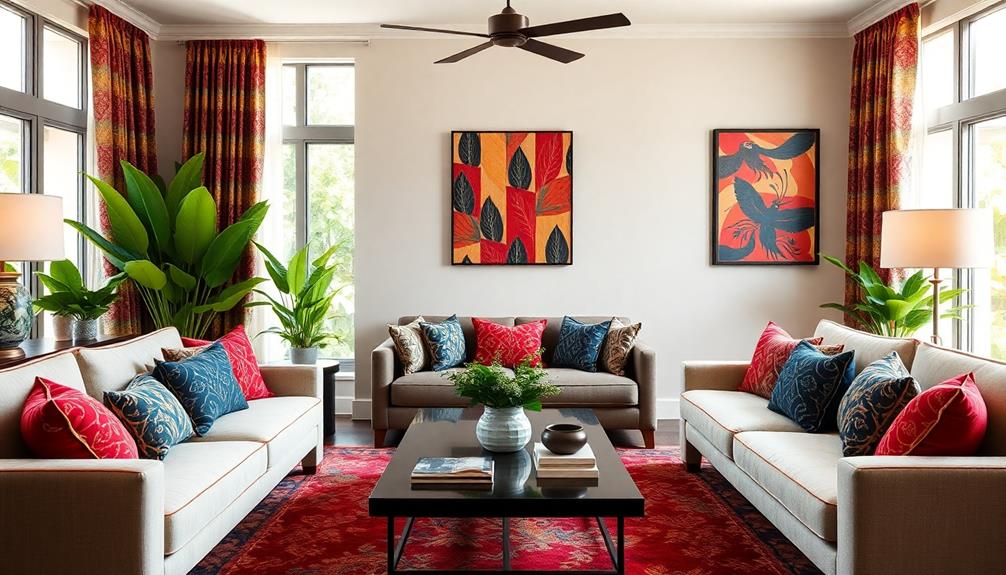
Batik is making a vibrant comeback in contemporary interior design, bringing its rich patterns and colors into modern living spaces.
You'll find batik fabric woven into a variety of accent pieces like cushions, curtains, and upholstery, adding cultural richness and unique visual interest to your home. Designers are skillfully blending traditional motifs with contemporary aesthetics, creating versatile home decor items that resonate with both heritage and modern style.
This approach mirrors the emphasis on using natural materials and traditional textiles seen in traditional Indonesian style home decor, enhancing aesthetic appeal.
Consider incorporating batik as a focal point in your space. Wall-mounted batik panels or art pieces can showcase the intricate craftsmanship of this textile art form, instantly elevating a room's design.
The growing popularity of batik in interior design reflects a broader trend of integrating cultural textiles into modern spaces, promoting global awareness and appreciation for artisanal practices.
Integrating Batik Into Interiors
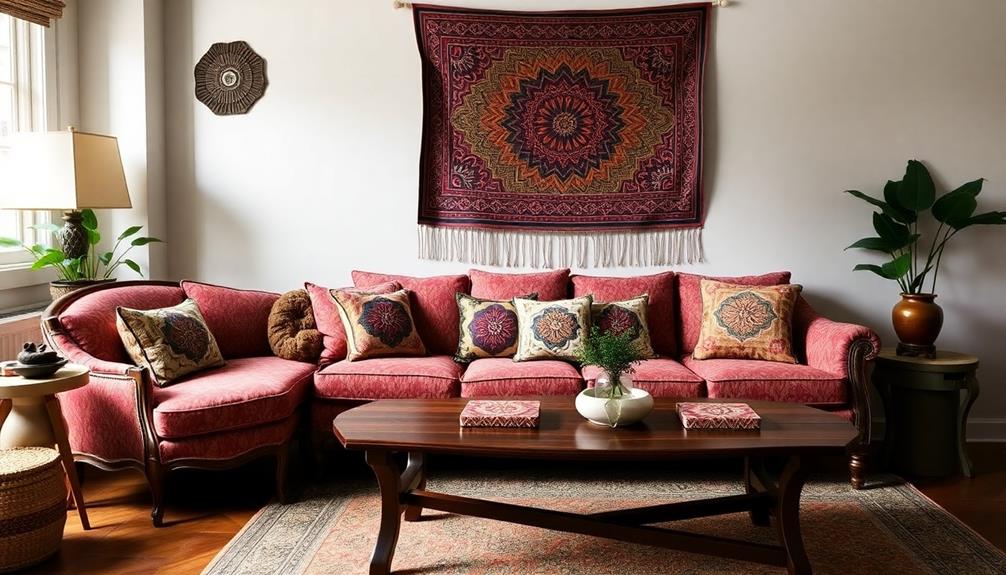
Incorporating batik into your interior design can bring a unique flair to your home while celebrating its cultural significance. Batik textiles, known for their vibrant patterns and rich heritage, enhance interior decor through cushions, curtains, and tablecloths. This perfect blend of traditional craftsmanship and modern design suits various styles, from bohemian to contemporary aesthetics.
To help you visualize how to integrate batik into your home, consider the following table:
| Element | Description |
|---|---|
| Cushions | Add color and comfort with batik prints. |
| Curtains | Create a stunning backdrop for any room. |
| Antique Batik | Use as focal points for visual interest. |
| Accent Pieces | Incorporate batik in small doses to avoid overwhelming your space. |
| Upholstery | Showcase the versatility of batik in functional furniture. |
Batik Techniques and Styles

Exploring batik techniques reveals a fascinating tapestry of artistry and tradition, each method offering unique characteristics.
You'll find that traditional batik-making primarily includes Batik Tulis, where skilled artisans hand-draw intricate designs using hot wax. This painstaking process results in exquisite patterns that showcase creativity and often incorporates cultural symbolism, reflecting the rich heritage of Indonesia's traditional housing styles.
On the other hand, Batik Cap utilizes copper stamps for quicker production, allowing for more widespread use of batik fabrics.
The dyeing technique in batik often involves applying wax, dyeing with natural colors derived from plants and minerals, and ultimately removing the wax to disclose detailed motifs.
If you're interested in modern adaptations, Batik Lukis allows for painting on fabric, merging traditional methods with contemporary artistic expression.
Don't overlook Batik Pesisir, which reflects coastal influences, characterized by bolder colors and designs aimed at commercial markets.
Finally, Batik Belanda combines Western elements with Javanese traditions, illustrating how batik adapts and evolves across cultures.
Whether you're drawn to the elegance of cotton or silk batik fabrics, each style offers something distinct for your interior design choices.
Global Influence on Batik

The intricate techniques and vibrant styles of batik have sparked a global fascination since the 1800s, as European traders introduced this unique art form to a wider audience. You can see batik's global influence in various facets of modern life, where it's embraced by international fashion designers and celebrated in contemporary styles.
| Cultural Impact | Examples |
|---|---|
| Fashion | Collections with traditional motifs |
| Decorative Arts | Adaptations in modern textiles |
| Global Reach | Influences in Nigeria, Ghana, India |
| Heritage | Recognized as a cultural symbol |
As Dutch and French artists adapted batik techniques, they contributed to the evolution of modern decorative arts, showcasing how versatile this art form can be. Today, you might spot batik on haute couture runways or worn by celebrities, further solidifying its status as a cultural symbol. The art form continues to adapt, merging with local textiles and reflecting diverse heritage, while maintaining its traditional motifs. This blend of history and innovation makes batik a fascinating subject in the world of design.
Celebrating Local Artisans and Craftsmanship

Through the revival of batik in interior design, local artisans and their craftsmanship are gaining the recognition they deserve. Supporting these artisans sustains traditional craftsmanship and fosters community development and economic growth in Indonesia.
You'll find that many batik artisans employ sustainable practices, using natural dyes and eco-friendly processes that enhance the cultural and environmental value of their work. Additionally, the integration of batik with tropical-themed luxury designs can elevate the aesthetic appeal of modern interiors.
Collaborations between designers and local artisans have led to the creation of unique, contemporary products that honor traditional techniques while appealing to modern consumers. This resurgence of batik in interior design showcases the intricate craftsmanship of local artisans in home decor items like cushions, curtains, and wall art.
Moreover, batik workshops and exhibitions are essential in highlighting the skills of these craftsmen. They provide educational opportunities that promote appreciation for this cultural heritage, especially among younger generations and tourists.
Frequently Asked Questions
What Is the Cultural Significance of Batik?
Batik's cultural significance lies in its rich history, representing diverse traditions and social values. Each motif tells a story, connecting you to community bonds and significant life events, while preserving cultural identity and artisanal craftsmanship.
What Does the Batik Symbolize?
You might think batik's just pretty fabric, but it symbolizes deep cultural heritage and identity. Each intricate pattern tells a story, revealing meanings like balance, power, and protection that connect you to rich traditions.
What Is the Basis of Modern Batik Design?
Modern batik design blends traditional motifs with contemporary aesthetics, appealing to diverse audiences. You'll find it utilizes sustainable materials and synthetic dyes, ensuring vibrant patterns while catering to eco-conscious consumers and fast-paced market demands.
What Is the Meaning of Batik Pattern Design?
Batik pattern designs carry rich meanings, reflecting cultural values and stories. Each motif you see symbolizes different beliefs, like balance, protection, or fertility, making your space not just beautiful but also meaningful and connected to heritage.
Conclusion
Incorporating batik into modern interior design not only enhances your space but also connects you to a rich cultural tapestry. By embracing the intricate motifs and techniques of this ancient art form, you celebrate both heritage and creativity. As you adorn your home with these vibrant textiles, you're not just decorating; you're telling a story that transcends time, much like a finely aged wine that only gets better with each passing year. So, go ahead and let batik inspire your surroundings!
- About the Author
- Latest Posts
Introducing Ron, the home decor aficionado at ByRetreat, whose passion for creating beautiful and inviting spaces is at the heart of his work. With his deep knowledge of home decor and his innate sense of style, Ron brings a wealth of expertise and a keen eye for detail to the ByRetreat team.
Ron’s love for home decor goes beyond aesthetics; he understands that our surroundings play a significant role in our overall well-being and productivity. With this in mind, Ron is dedicated to transforming remote workspaces into havens of comfort, functionality, and beauty.
Southeast Asia Decor
Batik: The Heartbeat of Modern Interior Design
Batik’s vibrant essence transforms modern interiors, but discover how its unique patterns can elevate your home decor in unexpected ways.
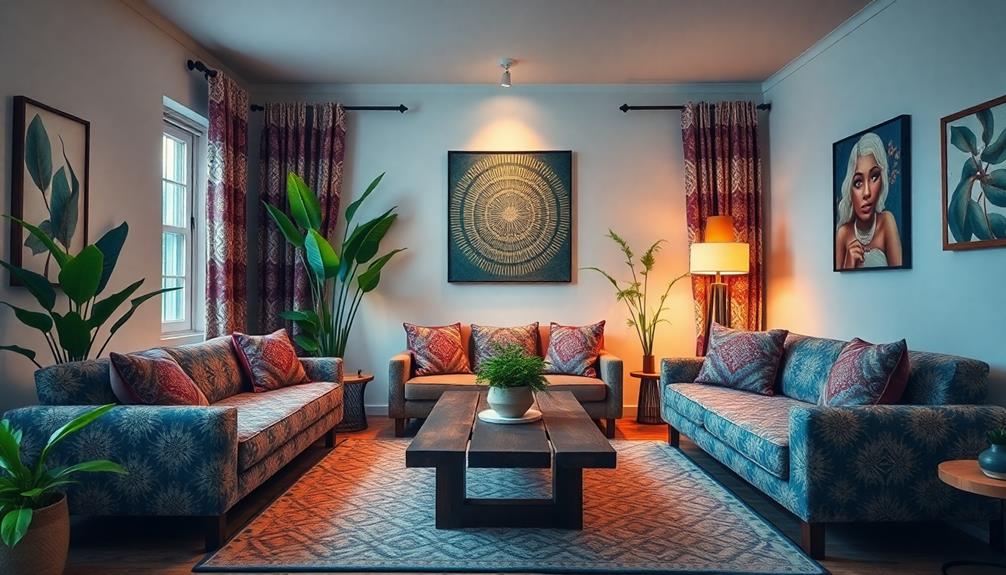
Batik's vibrant patterns and rich cultural heritage make it a standout in modern interior design. You can easily elevate your space with batik textiles, using them in cushions or as wall art to create striking focal points. This art form blends beautifully with natural materials like wood and bamboo, adding warmth and texture. By mixing bold batik designs with neutral colors, you'll craft a harmonious atmosphere that reflects personal style. So, if you're curious about how to seamlessly integrate batik into your home decor, there's plenty more to uncover that can inspire your creativity.
Key Takeaways
- Batik is an intricate Indonesian art form that enhances modern interiors with its vibrant colors and detailed patterns.
- The philosophy of Batik Interiores blends aesthetics and functionality, promoting harmony and individuality in design.
- Modern interior trends incorporate batik through innovative color palettes, texture fusion, and sustainable materials, reflecting cultural depth.
- Batik textiles add vibrancy and character to spaces, functioning well in upholstery, wall art, and accent pieces.
- Community engagement drives creativity in batik design, fostering collaboration and fresh ideas for contemporary applications.
The Essence of Batik
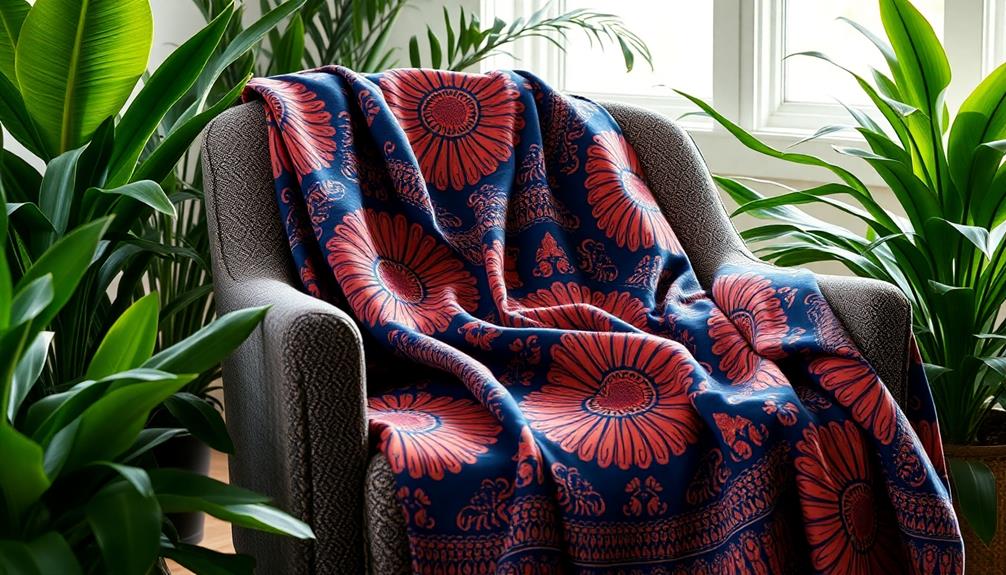
Batik's essence lies in its intricate artistry and cultural depth, offering a fascinating glimpse into Indonesian heritage. When you explore batik fabric, you'll discover a traditional dyeing technique that employs wax-resist methods to craft detailed patterns. This art form dates back over 2,000 years, showcasing its enduring significance across various cultures.
The term "batik" itself comes from the Javanese "bathikan," meaning drawing or mark-making, highlighting the skill involved in its creation. Additionally, batik is often incorporated into various decor elements, such as Indonesian decorative pillows, which reflect the vibrant colors and intricate patterns inherent in this craft.
Modern batik fabric has transformed to include contemporary designs and vibrant colors, making it a popular choice for interior decor. You can enhance your living space with batik through upholstery, curtains, and accent pieces, all while appreciating the rich textures and vivid patterns.
These designs often carry cultural significance, with specific motifs that express meanings tied to social status, nature, and history within Indonesian tradition.
Batik Interiores Philosophy
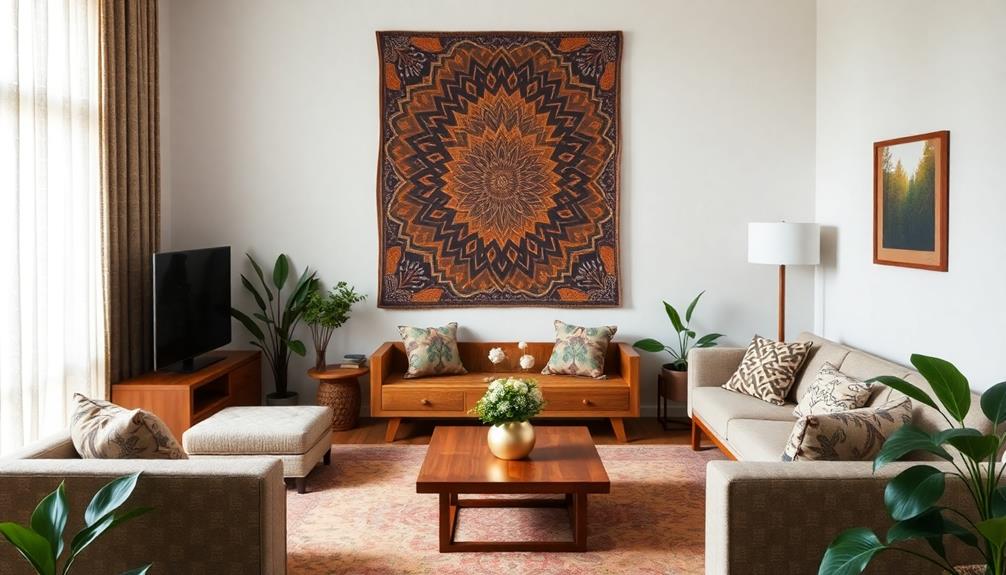
Incorporating batik into modern interior design goes beyond aesthetics; it embodies a philosophy that balances beauty with functionality. BATIK Interiores emphasizes a harmonious coexistence of design aesthetic and practicality, crafting spaces that are not only visually appealing but also functional.
This philosophy prioritizes individuality, power, harmony, and warmth, ensuring every design reflects your unique personality. The careful selection and balance of items is essential for enhancing livability and overall well-being.
| Element | Importance | Impact |
|---|---|---|
| Aesthetics | Creates visual appeal | Engages and inspires emotion |
| Functionality | Enhances usability | Supports daily activities |
| Light | Influences ambiance | Affects mood and comfort |
Trends in Modern Interior Design

In modern interior design, you're seeing exciting innovations in color palettes that energize spaces and influence moods.
The integration of traditional elements, such as Indonesian decor masks, adds a cultural depth and storytelling aspect to contemporary aesthetics.
Texture and pattern fusion has become essential, allowing you to mix different materials and designs for a unique look.
Plus, sustainable material choices, like batik, not only enhance aesthetics but also reflect a commitment to eco-friendly living.
Color Palette Innovations
Vibrant color palettes are revolutionizing modern interior design, and batik-inspired hues are leading the charge. You'll find that rich shades like deep blues, warm yellows, and soft pinks not only create dynamic spaces but also serve as powerful design inspiration.
Additionally, incorporating elements like the Indonesian decor mask can enhance the cultural richness of your interior. By blending traditional batik colors with contemporary materials, you can achieve a harmonious balance that resonates with both heritage and modern aesthetics.
Consider these elements to elevate your interior design:
- Contrast: Use bold batik patterns in textiles and wallpapers to create striking visual interest against neutral furnishings.
- Layering: Mix and match batik fabrics with solid colors. This layered look adds depth and personality to your space.
- Textures: Incorporate geometric and ethnic textures derived from batik, enhancing modern style while celebrating cultural significance.
- Innovative Materials: Explore the use of velvet and faux marble alongside batik patterns to create a luxurious, contemporary vibe.
These innovative color palette trends breathe new life into your space, allowing you to express your unique style while embracing the beauty of batik.
Texture and Pattern Fusion
Texture and pattern fusion is transforming modern interior design by seamlessly blending diverse materials, including batik textiles and Indonesian decor masks, to create visually enchanting spaces.
By incorporating batik patterns into your decor, you can reflect your personal style and cultural heritage while adding depth and character to your home. Designers are increasingly choosing batik-inspired motifs, often pairing them with solid colors to establish a balanced visual narrative.
Hand-drawn batik patterns are especially popular now, offering a sense of authenticity and artistry that resonates with those of you seeking personalized decor. These unique designs not only enhance the aesthetic appeal of your space but also celebrate traditional craftsmanship in a contemporary context.
The versatility of batik allows it to fit various design styles, from bohemian to modern minimalist, making it an adaptable choice for any interior.
As you explore texture and pattern fusion, consider using batik for accent pieces like cushions, wall art, or even throw blankets. This approach not only elevates your design but also invites conversation and admiration, transforming your living space into a mesmerizing reflection of who you are.
Sustainable Material Choices
As you embrace the fusion of textures and patterns in your interior design, consider how sustainable material choices can further enhance your space.
Integrating elements of tropical contemporary house design can also elevate your aesthetic while staying environmentally conscious. Sustainable interior design isn't just a trend; it's a commitment to a healthier planet and your well-being.
By opting for eco-friendly materials, you're not only beautifying your home but also making a positive impact.
Here are four sustainable material choices to inspire you:
- Reclaimed Wood: Every piece has a story, adding character and warmth to your space.
- Bamboo: Fast-growing and renewable, it's a stylish alternative that benefits the environment.
- Organic Fabrics: Soft, breathable, and free from harmful chemicals, they contribute to healthier living.
- Recycled Plastics: Innovative and practical, these materials help reduce waste while looking chic.
With certifications like LEED and FSC, you can trust that your choices support responsible sourcing.
Plus, the rise of biodegradable and non-toxic options makes it easier than ever to create a stunning interior that reflects your values.
Embrace sustainable material choices, and let your home tell a story of style, responsibility, and connection to nature.
Integrating Batik Into Home Decor
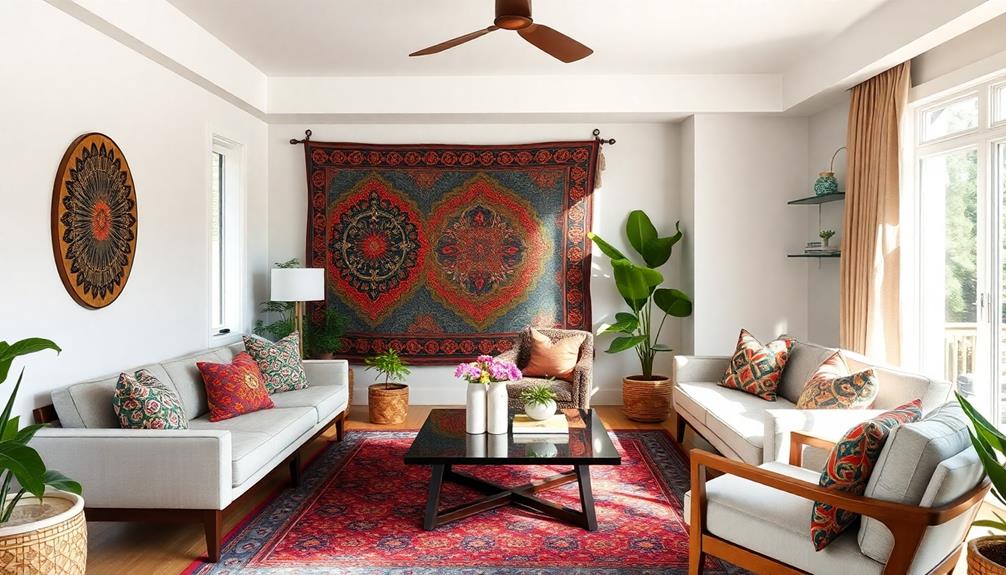
When integrating batik into your home decor, start by selecting vibrant patterns that resonate with your personal style.
Consider incorporating elements of traditional Indonesian style to enhance the aesthetic appeal, as batik beautifully complements natural materials like wood and bamboo.
Pair these patterns with complementary color schemes to create a cohesive look that enhances your space.
Don't forget practical application tips, like using batik for upholstery or as wall art, to make a bold statement without overwhelming your design.
Vibrant Pattern Selection
Incorporating batik-inspired textiles into your home decor instantly adds a splash of vibrancy and character. With their intricate patterns, these textiles can elevate your interior design, making each room feel more inviting.
Additionally, Balinese design characteristics celebrate the use of traditional motifs, which can beautifully complement the rich textures of batik. When you're ready to make a vibrant pattern selection, consider these four inspiring ideas:
- Accent Cushions: Throw pillows covered in bold batik designs can transform your sofa into a vibrant focal point.
- Dramatic Curtains: Hang batik-patterned curtains to create an eye-catching backdrop that enhances natural light while adding texture.
- Unique Upholstery: Reupholster a vintage chair or an ottoman with batik fabric for a statement piece that tells a story.
- Artistic Throws: Drape a batik throw over a neutral armchair to introduce warmth and cultural flair to your space.
The versatility of batik allows it to blend seamlessly with various design styles, from modern bohemian to traditional.
Complementary Color Schemes
Batik textiles can truly bring a room to life, but pairing them with the right colors is key to creating a cohesive look. Complementary color schemes, which involve colors opposite each other on the color wheel, can enhance the vibrant patterns found in batik. For instance, using blue and orange can create a striking balance that highlights the intricacy of the batik design.
Additionally, incorporating elements of traditional Indonesian housing can inspire the overall aesthetic of your space, blending cultural heritage with modern decor.
When integrating batik into your modern interior, consider the dominant colors within the textile. This will guide you in selecting complementary hues for your walls, furniture, and accessories, ensuring a harmonious environment. Using batik in accent pieces like cushions or throws allows you to incorporate rich colors without overwhelming the decor.
Don't shy away from experimenting with various shades and tones of complementary colors. This can lead to dynamic and visually appealing spaces where your batik textiles shine as focal points.
Practical Application Tips
Integrating batik into your home decor can be both exciting and rewarding, as it allows you to infuse your space with cultural richness and artistic flair.
To enhance the tropical aesthetic of your interiors, consider incorporating elements from luxury tropical design aesthetics that complement batik patterns. Here are some practical tips to help you seamlessly incorporate batik designs into your interior:
- Accent Pieces: Use batik textiles like throw pillows or cushions to introduce vibrant patterns without overwhelming your space. These small touches can make a big impact.
- Feature Walls: Consider batik-inspired wallpaper to create a stunning feature wall. It adds depth and character, but ascertain it complements your overall color scheme for a harmonious design.
- Upholstery: Incorporate batik fabric in your furniture upholstery. This unique touch reflects your personal style while still being functional.
- Layering Textiles: Combine batik with solid color fabrics and natural materials like cotton or leather. This balance prevents visual clutter and enhances texture, creating a warm, inviting atmosphere.
Unique Batik Products and Inspirations
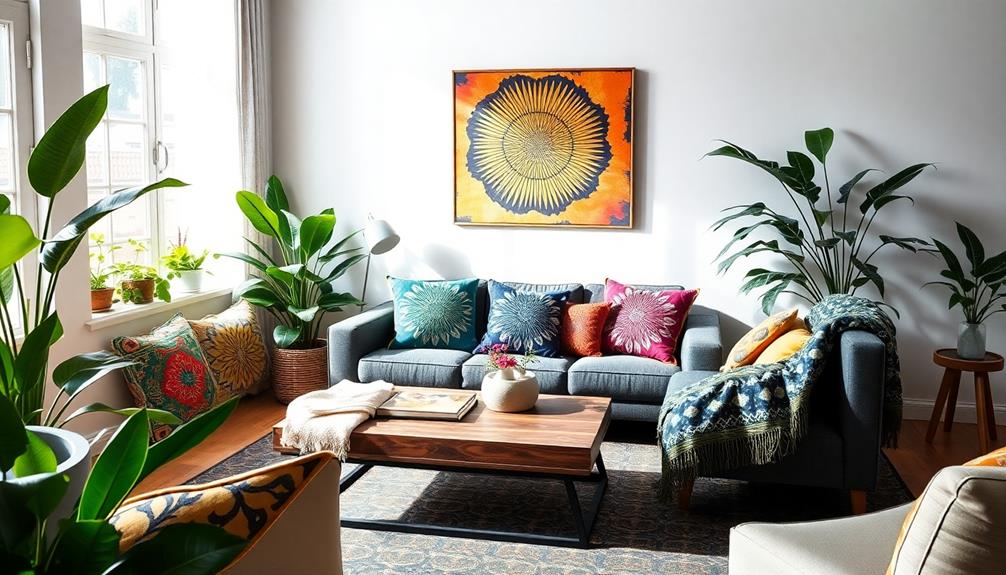
Unique batik products, like stunning bespoke furniture and vibrant textiles, can transform your living space into a work of art. These pieces showcase intricate patterns and craftsmanship that elevate modern interior design aesthetics.
Imagine a statement chair upholstered in rich batik fabric, or a coffee table featuring batik-inspired faux marble accents. Each product tells a story, drawing inspiration from natural landscapes and historical motifs, resulting in distinctive patterns that resonate with contemporary decor themes.
By incorporating elements from luxury tropical designs, batik can seamlessly blend with modern aesthetics while adding a touch of cultural richness.
The versatility of unique batik products allows them to shine in various forms, including wall art, upholstery, and decorative accents. This flexibility means you can easily incorporate batik into any room, adding character and depth to your space.
By blending traditional techniques with modern design elements, batik celebrates cultural heritage while appealing to current tastes.
To achieve a luxurious feel, consider using rich materials like velvet alongside batik designs. This combination not only enhances the aesthetic but also maintains a connection to the craftsmanship that defines batik.
Embrace the beauty of unique batik products, and watch as your home transforms into a vibrant, culturally rich haven that reflects your style.
Community Engagement and Feedback
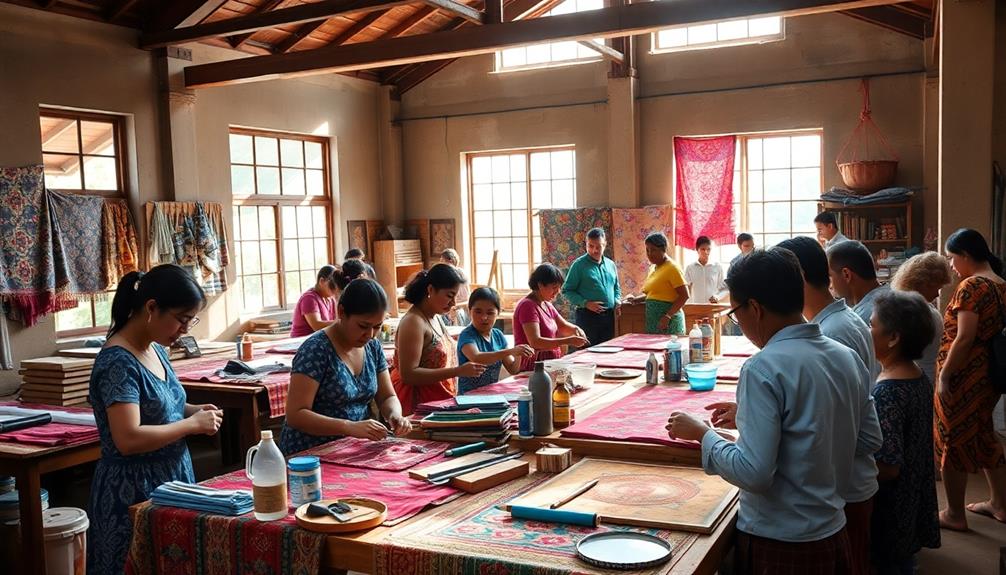
Incorporating batik into modern interior design isn't just about the products; it's also about the vibrant community that surrounds this art form.
Community engagement plays a significant role in shaping your design journey. By actively seeking feedback and interacting with fellow quilters, you open the door to collaboration and shared inspiration.
Here's why engaging with your community matters:
- Supportive Comments: When you share your designs, the encouraging feedback fosters a positive atmosphere for creativity.
- Open Dialogue: Maintaining an ongoing conversation allows everyone's voices to be valued and integrated into future projects.
- Innovative Ideas: Community feedback is essential, guiding the direction of new fabric designs and collections that resonate with shared tastes.
- Social Media Connection: Platforms like Instagram and Facebook create spaces for interaction, showcasing your designs while gathering fresh perspectives.
The Future of Batik Design
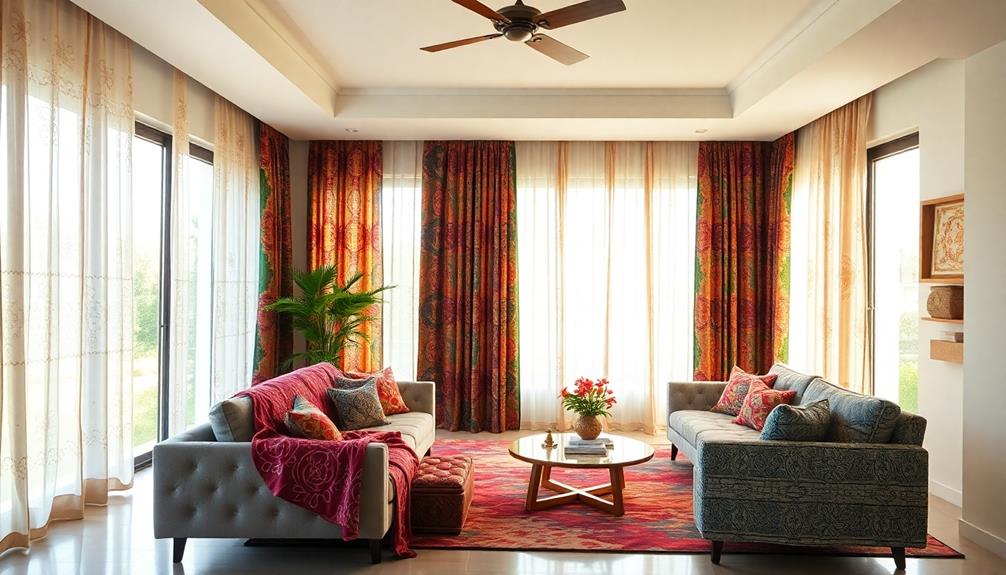
The future of batik design is set to embrace a dynamic blend of tradition and modernity, appealing to both established enthusiasts and new admirers alike.
As an interior designer, you'll find yourself at the forefront of this exciting evolution. Modern interpretations of batik are integrating traditional techniques with contemporary aesthetics, broadening its appeal across diverse audiences.
You'll notice designers experimenting with vibrant color palettes and playful patterns, encouraging a mix-and-match approach in home decor and fashion.
Innovations in textile technology are also enhancing batik fabrics, allowing them to retain the craftsmanship of traditional methods while introducing fresh design possibilities.
With consumers increasingly prioritizing sustainable and ethically produced textiles, you'll see batik design adapting to these values.
This growing demand for eco-friendly options honors cultural heritage while ensuring relevance in today's market.
Collaborative efforts between traditional artisans and modern designers are essential in this revival, fostering creativity and ensuring batik's adaptability in the ever-evolving landscape of interior design.
Frequently Asked Questions
What Is the Basis of Modern Batik Design?
Modern batik design blends traditional techniques with contemporary aesthetics. You'll see vibrant colors and innovative patterns, influenced by designers like Alison Glass. Experimentation and hand-drawn details create unique pieces that reflect current trends and craftsmanship.
Why Is Batik Important?
Batik's importance lies in its fusion of tradition and innovation. You'll find its rich patterns breathe life into spaces, bridging cultural heritage with modern aesthetics, creating environments that resonate warmth, storytelling, and individuality.
What Is a Batik Design?
A batik design is a textile pattern created using a wax-resist dyeing technique. You'll see intricate motifs that often hold cultural significance, showcasing artistry and tradition, while also adapting to modern aesthetics and color palettes.
Why Is Batik a Unique Form of Art?
Batik's uniqueness lies in its intricate wax-resist dyeing technique, allowing you to create stunning patterns. Each piece reflects cultural narratives and personal expression, making it a vibrant art form that connects you to rich traditions.
Conclusion
As you weave batik into your home, you're not just decorating; you're stitching together stories of culture and creativity. Each vibrant pattern dances across your walls, breathing life into your space, like a warm embrace on a chilly day. Embrace the tapestry of tradition and contemporary flair, and let batik be the heartbeat of your modern interior. With every piece you choose, you're not just enhancing your decor; you're celebrating a rich heritage that inspires and connects us all.
- About the Author
- Latest Posts
Introducing Ron, the home decor aficionado at ByRetreat, whose passion for creating beautiful and inviting spaces is at the heart of his work. With his deep knowledge of home decor and his innate sense of style, Ron brings a wealth of expertise and a keen eye for detail to the ByRetreat team.
Ron’s love for home decor goes beyond aesthetics; he understands that our surroundings play a significant role in our overall well-being and productivity. With this in mind, Ron is dedicated to transforming remote workspaces into havens of comfort, functionality, and beauty.
Southeast Asia Decor
7 Tips for Batik Symbolism in Modern Interiors
Bring your modern interiors to life with batik symbolism through these seven essential tips that will completely transform your space. Discover the secrets inside!

To enhance your modern interiors with batik symbolism, start by embracing traditional motifs like Parang and Kawung for a touch of heritage. Choose complementary colors to create balance, letting vibrant batik patterns shine. Integrate textiles thoughtfully, pairing them with solid elements to avoid overwhelming the space. Use batik pieces as focal points to draw attention and spark conversation. Mix these designs with contemporary elements for a stylish contrast. Highlight cultural stories behind the motifs to deepen your decor's meaning. Finally, maintain visual balance by selecting just a few standout pieces. You'll discover even more strategies that can transform your space beautifully.
Key Takeaways
- Incorporate traditional batik motifs like Parang and Kawung to symbolize continuity and prosperity in modern interiors.
- Use batik textiles as statement pieces to highlight cultural stories and add depth to your decor.
- Balance vibrant batik patterns with solid elements to maintain harmony and prevent visual overwhelm in your space.
- Select batik as focal points in key areas to create conversation starters and elevate the aesthetic appeal of your home.
- Experiment with complementary colors from batik fabrics to enhance mood and ensure cohesive integration within your existing color scheme.
Embrace Traditional Motifs
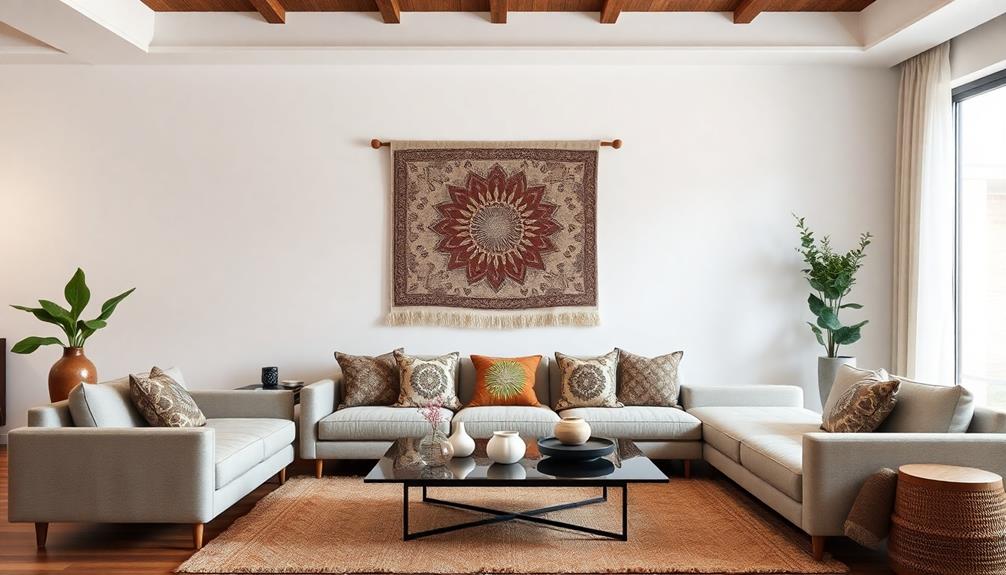
Embracing traditional motifs in your modern interior can transform your space into a vibrant tapestry of culture and history. Incorporating batik motifs like Parang and Kawung not only enhances aesthetic appeal but also adds a layer of cultural heritage to your home.
These designs carry significant meanings, highlighting themes of continuity and prosperity. Additionally, using Indonesian Decorative Pillows featuring batik patterns can further enrich your decor while providing comfort.
You can utilize traditional batik textiles as wall art or upholstery, creating striking focal points that serve as conversation starters. Selecting specific designs, such as Mega Mendung, can influence the mood of a room; its calming cloud motif promotes tranquility in a bedroom.
Mixing batik with contemporary furniture creates a harmonious balance between traditional and modern styles, ensuring your decor feels unique and inviting.
Emphasizing batik symbols like Sido Luhur can further enrich your living space, infusing it with positive energy and personal significance.
Choose Complementary Colors
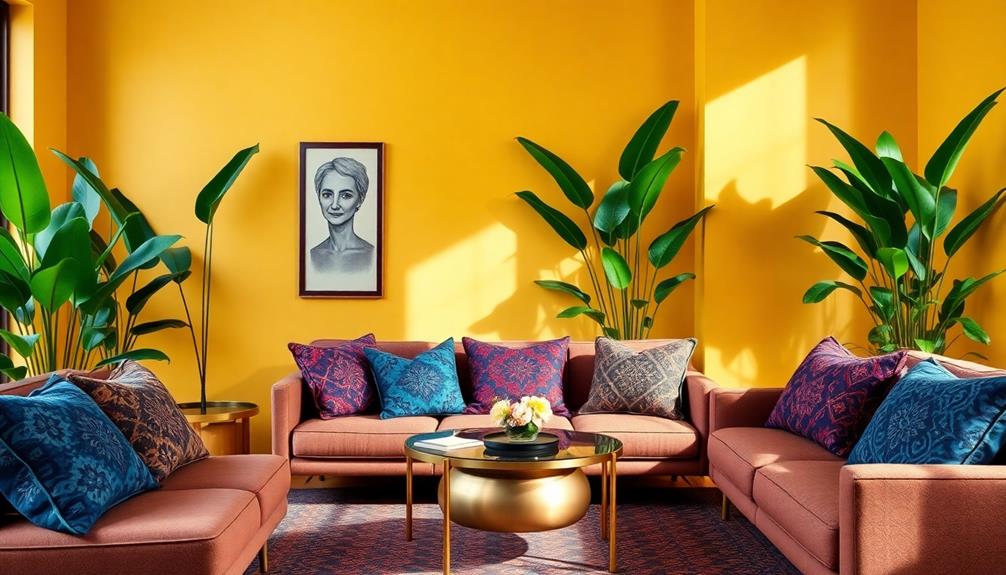
When you choose complementary colors for your batik decor, think about how they interact with your existing elements.
Incorporating elements like traditional artistry can help enhance the vibrancy of your batik patterns.
Balancing accent and dominant colors helps create harmony while ensuring the vibrant batik patterns shine without overwhelming the space.
Color Harmony Principles
Choosing complementary colors is essential for creating a vibrant and visually appealing space when incorporating batik textiles into modern interiors. By selecting colors that sit opposite each other on the color wheel, you can enhance the vibrancy of your batik patterns and establish a striking contrast.
Here's a quick guide to help you choose complementary colors effectively:
| Warm Colors | Complementary Color | Use Case |
|---|---|---|
| Red | Green | Living room textiles |
| Yellow | Purple | Dining area accents |
| Orange | Blue | Accent pillows |
| Pink | Teal | Bedroom decor |
Incorporating warm batik designs can evoke warmth and energy, perfect for social spaces. On the other hand, cool-toned batik patterns promote tranquility, ideal for bedrooms. To achieve true color harmony, consider mixing your batik textiles with solid colors within the same family. This approach allows the intricate batik patterns to shine without overwhelming the area. Experimenting with different shades of a color found in your batik fabrics can also create depth, making your interior feel cohesive yet dynamic.
Accent vs. Dominant Colors
In modern interiors, finding the right balance between accent and dominant colors is essential for showcasing the beauty of batik textiles. When you integrate batik patterns into your space, choose accent colors from the fabric that complement the room's dominant shades. This creates a harmonious design that draws the eye without overwhelming the decor.
Incorporating elements like Indonesian decor masks alongside batik can enhance the cultural depth of your interior while maintaining visual interest.
Using batik pieces with vibrant colors as focal points against neutral backgrounds allows the intricate designs to shine. Consider the psychology of color; warm tones can create a cozy atmosphere, while cool tones evoke calmness.
Mixing batik textiles with solid color furnishings helps maintain balance, ensuring the batik patterns remain the centerpiece.
To enhance visual interest, select complementary colors that echo the motifs in the batik. Pair a batik print with matching throw pillows or art pieces that reflect similar hues.
This thoughtful approach to accent colors not only elevates your interior design but also celebrates the rich cultural significance of batik. Remember, the goal is to create a cohesive look where each element enhances the other, allowing the beauty of your batik textiles to truly stand out.
Integrate Textiles Thoughtfully
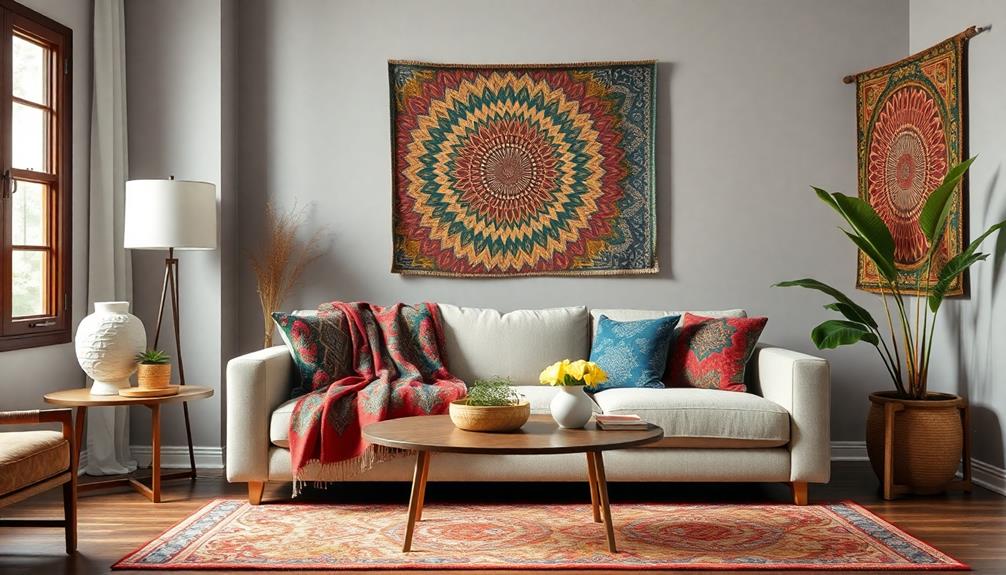
When integrating batik textiles into your space, think about how they complement your color scheme.
Incorporating traditional motifs and patterns can enhance the cultural significance of your decor, making it more meaningful. Mixing batik with solid elements helps maintain a balanced look, so the patterns enhance rather than overwhelm your decor.
By choosing colors that resonate with your overall design, you can create a harmonious atmosphere that feels both inviting and stylish.
For inspiration, consider exploring Indonesian wedding decor ideas.
Choose Complementary Color Schemes
Integrating batik textiles into your modern interior can transform a space, especially when you select complementary color schemes that resonate with your existing decor.
Start by identifying colors within your chosen batik patterns; these textiles often feature a blend of earthy tones and vibrant hues from traditional batik-making. Pair warm earth tones with cooler accent colors to create a harmonious balance that enhances the overall aesthetic.
Additionally, consider incorporating elements of Balinese design characteristics that harmonize with your batik textiles, such as natural materials and open spaces that promote a connection to nature.
Consider the scale of your batik patterns as you decide where to place them. Larger motifs can act as striking statement pieces, while smaller patterns work beautifully as accents, such as in cushions or throws. This allows you to introduce batik textiles into various areas without overwhelming the environment.
To further highlight the intricate designs of your batik textiles, utilize neutral backgrounds. This approach not only emphasizes the beauty of the fabrics but also maintains a serene atmosphere in your space.
Balance With Solid Elements
To create a balanced and inviting space, pair your vibrant batik textiles with solid elements that ground the design. Mixing solid-colored furniture and decor items with batik patterns provides a visual anchor that complements the bold motifs while maintaining an elegant look. Opt for neutral tones to enhance the intricate designs without overwhelming your interiors.
Using batik textiles as accent pieces, like cushions or throws, introduces cultural elements subtly, ensuring they enhance rather than dominate the overall aesthetic. Consider the scale of your batik prints; larger patterns can be beautifully balanced with smaller solid elements, creating a harmonious interplay of textures and colors.
A layered approach works wonders too. For instance, using a batik table runner on a solid tablecloth adds depth while preserving the integrity of both fabrics. Here's a quick reference to help you balance solid elements with batik textiles:
| Solid Element Type | Suggested Batik Piece | Ideal Placement |
|---|---|---|
| Neutral Sofa | Batik Cushions | On the sofa |
| Solid Coffee Table | Batik Table Runner | On the table |
| Plain Curtains | Batik Throw | On a chair |
Use Batik as Focal Points

Batik can transform your space by serving as a striking focal point that captures attention and adds depth to your decor.
By thoughtfully incorporating batik elements, you can create an inviting atmosphere that showcases the beauty of these traditional patterns. Additionally, using batik decor can promote appreciation for Indonesian artistry and craftsmanship, enhancing the cultural richness of your home cultural decor enthusiasts.
Here are three effective ways to use batik as focal points in your home:
- Batik Wall Hangings: Use large batik wall hangings or framed fabric pieces as statement art. They draw the eye and create a vibrant atmosphere in any room.
- Upholstered Furniture: Consider batik upholstered furniture, like chairs or sofas, to introduce rich colors and intricate designs that can become the centerpiece of your living space.
- Textiles in Decor: Display batik cushions and throws on neutral-colored sofas or beds. They highlight the unique patterns and add a touch of cultural elegance to your decor.
Mix With Contemporary Elements

Adding batik elements to your decor doesn't mean sticking solely to traditional styles. You can seamlessly mix batik fabric with modern design to create a unique aesthetic.
Consider incorporating batik patterns into contemporary furniture, like upholstered chairs or ottomans, which aligns with the principles of modern tropical aesthetics in Bali. This allows you to showcase traditional artistry while embracing clean lines and minimalism.
Using batik textiles as wall art adds another layer of artistic expression to your space. Frame pieces or create a gallery wall, letting the vibrant colors and intricate patterns become focal points in otherwise minimalist environments.
You can also blend batik with modern textiles—think solid-colored cushions or throws—to maintain an elegant, cohesive look in your living areas.
Combine batik elements with sleek metallic accents, such as gold or silver decor items, to enhance the richness of the fabric while adding a contemporary flair.
Ultimately, consider batik-inspired wallpapers or decals in your modern spaces. They allow timeless motifs to add depth and cultural richness without overwhelming your design.
Highlight Cultural Stories

Incorporating batik textiles into your modern interiors can transform your space into a rich tapestry of cultural stories. Each piece tells a tale, offering a glimpse into traditions and heritage that can captivate your guests.
As traditional Indonesian housing, or Rumah Adat, reflects deep cultural significance, so too can batik textiles enrich your home with their historical narratives.
Here are three ways to highlight these narratives:
- Choose Iconic Batik Motifs: Select pieces with significant meanings, like the Parang, representing continuity and ocean waves, enriching your decor with a royal Indonesian legacy.
- Emotional Connections: Display textiles featuring symbols like Sido Asih, which embodies love. This not only beautifies your space but also enhances emotional resonance.
- Showcase Cultural Craftsmanship: Use batik items as accent pieces to demonstrate your appreciation for the intricate artistry and stories behind each design.
Maintain Balance in Design
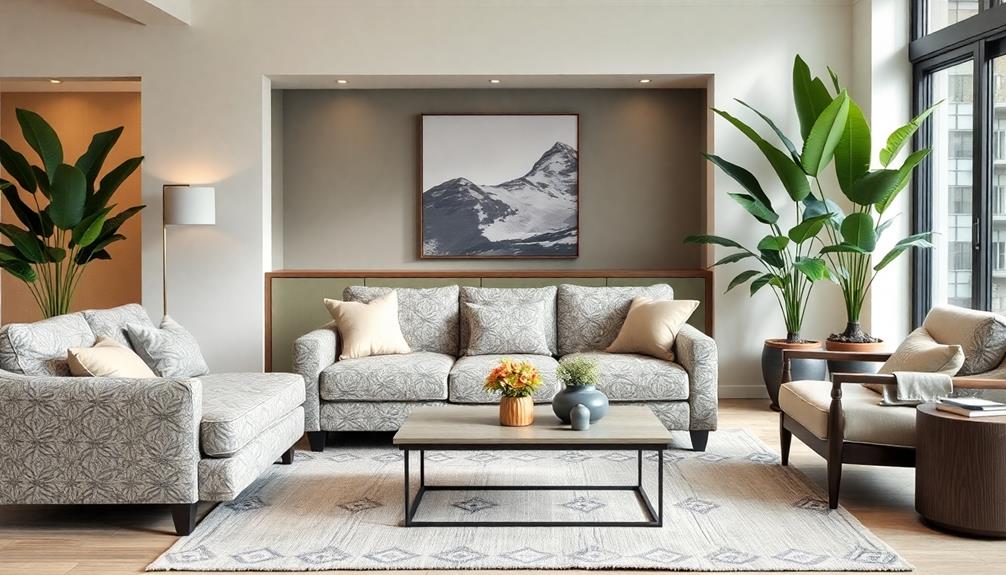
Achieving harmony in interior design often hinges on the balance of elements within a space. When incorporating batik into your modern interiors, start by selecting one or two prominent batik pieces as focal points. This prevents your space from feeling overcrowded with patterns and allows the intricate details of the batik design to shine.
For a truly immersive experience, consider integrating elements from traditional Indonesian style home decor that resonate with the cultural significance of batik. Complement bold batik designs with solid color furnishings, creating a harmonious contrast that enhances the overall decor.
Consider using batik in accent pieces like throw pillows or wall art. This approach not only allows for easy seasonal updates but also maintains a cohesive design theme throughout the room. Pay attention to the scale of batik patterns; larger motifs can dominate a space, so pair them with smaller, subtler designs to maintain visual balance and interest.
Integrate batik into a layered design by mixing traditional garments with modern art and textures like wood, metal, or natural fibers. This creates depth and an inviting atmosphere while keeping your decor elegant.
Frequently Asked Questions
What Does the Batik Symbolize?
Batik symbolizes various cultural meanings, like honor, unity, and power. By understanding these motifs, you can appreciate their significance, enhancing your connection to the rich traditions they represent while adding beauty to your environment.
What Are the 5 Major Types of Batik Design Motif?
The five major batik motifs you should know are Kawung, Parang, Sido Asih, Mega Mendung, and Ceplok. Each design carries unique meanings and can enhance your interior decor with cultural significance and aesthetic appeal.
What Is the Basis of Modern Batik Design?
Modern batik design combines traditional motifs with contemporary aesthetics, much like a smartphone blends technology and style. You'll see nature-inspired themes and vibrant colors, reflecting cultural stories while appealing to today's audience.
What Are the Three Main Elements of Batik Pattern?
The three main elements of batik patterns are motifs, colors, and arrangement. You'll notice how motifs symbolize nature and values, colors convey emotions, and arrangement enhances the flow, creating meaningful and enchanting designs.
Conclusion
Incorporating batik into your modern interiors can create a beautiful harmony between tradition and contemporary design. For instance, imagine a living room where a bold batik throw pillow complements sleek, minimalist furniture, telling a story of rich heritage. By following these tips, you'll not only enhance your space but also celebrate the cultural significance behind the patterns. Embrace the journey of blending old and new, and watch your home come alive with character and meaning.
- About the Author
- Latest Posts
Introducing Ron, the home decor aficionado at ByRetreat, whose passion for creating beautiful and inviting spaces is at the heart of his work. With his deep knowledge of home decor and his innate sense of style, Ron brings a wealth of expertise and a keen eye for detail to the ByRetreat team.
Ron’s love for home decor goes beyond aesthetics; he understands that our surroundings play a significant role in our overall well-being and productivity. With this in mind, Ron is dedicated to transforming remote workspaces into havens of comfort, functionality, and beauty.
-

 Retreat2 weeks ago
Retreat2 weeks agoDIY Aromatherapy Diffusers for a Spa-Like Atmosphere at Home
-

 Retreat3 weeks ago
Retreat3 weeks agoThe Profitability of Retreat Centers: A Financial Analysis
-
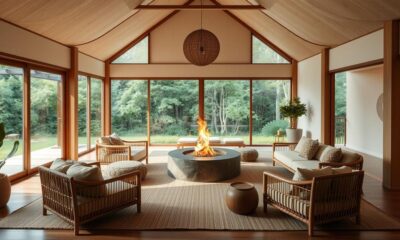
 Retreat1 week ago
Retreat1 week ago10 Unique Themed Room Ideas for Your Retreat Center
-

 Retreat2 weeks ago
Retreat2 weeks agoThe Psychology of Color in Retreat Center Design
-

 Southeast Asia Decor7 days ago
Southeast Asia Decor7 days agoIndonesian Textiles Shaping Contemporary Interior Design
-

 Retreat2 weeks ago
Retreat2 weeks agoUnusual DIY Projects: Designing a Space Probe in Bitlife
-

 Retreat3 weeks ago
Retreat3 weeks agoComprehensive Review: Are Home Decorators Ceiling Fans Worth the Investment?
-

 Retreat2 weeks ago
Retreat2 weeks agoHow to Create a Zen Garden for Your Retreat Center











